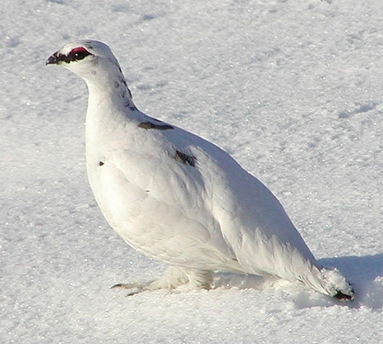Ptarmigan

On Sunday 7 March 2010, some Ptarmigan were reported on Coire nam Meann ridge on the approach to Goatfell. The observer was able to approach within eight metres of a group of five. This is the largest group reported on the island since 1995 and caused great excitement. Frustratingly other observers have not yet been able to confirm their presence.
Arran has the most southerly population of Ptarmigan in the UK and recent records have been sparse. There were none in 2009 and in 2008, when the National Trust for Scotland conducted an extensive survey, there was only one record.
Within the British Isles, Ptarmigan distribution is currently restricted to the Scottish mountains. There is evidence that this species occurred in the English Lake District until the end of the eighteenth century and in the Scottish Southern Uplands until the early nineteenth century.
On Arran in the twentieth century there were no records from 1900 until the seventies. Valerie Thom in “Birds of Scotland 1986” cites 1977 as the first breeding record on Arran in the twentieth century. It is believed that the species return could have come via
a cyclical population explosion such as happened in the Cairngorms area in 1971 and 1972. On these occasions birds would have been forced into new areas like Arran in search of food. There is speculation that this latest sighting may be a result of the coldest winter for decades again encouraging some birds to move out of their strongholds further north.
The Scottish Ptarmigan (Lagopus mutus millaisi) is endemic to Scotland and is recognised as one of up to thirty subspecies that are circumpolar. To illustrate this note is a photograph taken by Tony Church on Beinn Bhreac in January 2003, although the birds reported in March this year were not all white. All Ptarmigan moult their body feathers three times a year, a phenomenon exhibited by only a few other species, from white in winter, to mottled brown in summer and grey in autumn. This Scottish sub species adopts a more complete grey phase and keeps it longer. Some birds retain some grey feathers throughout the winter. The plumage has probably evolved as a cryptic colouration adapted to the Scottish mountains.
The favoured habitat is herb-rich arctic-alpine heath in association with exposed bedrock. Rocks are used to provide cover from predators and weather. This habitat is usually found at over 600m altitude in the Scottish mountains, but Ptarmigan and their habitat can be found down to 200m in the extreme Northwest Highlands. Scottish Ptarmigan feed mainly on the shoots and leaves of dwarf-shrubs. They take many new shoots and berries in summer, when they feed mostly on mountain crowberry, blaeberry/bilberry, heather and dwarf willow. In winter they take a higher proportion of heather, but also crowberry and blaeberry.
Most territorial cocks pair with one hen, but a few with two and some are unmated. Hens mostly start to lay in mid-late May, exceptionally at the end of April or early May, the typical clutch being 6-9 eggs. Only one brood per year is reared, but birds often relay if the first clutch is destroyed. Chicks are almost adult-sized by mid August.
Arran’s Ptarmigan population is just hanging on. Ptarmigan are a difficult species to count accurately owing to their remote habitat, camouflaged plumage and secretive behaviour, although at times they can be quite confiding, as in the photograph. Anyone on the hills this spring and summer is encouraged to look out for Ptarmigan and to report all sightings. This would be much appreciated.